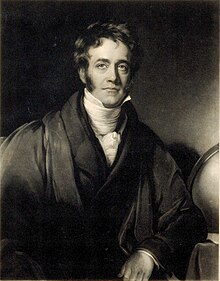
Back John Herschel Afrikaans جون هيرشل Arabic چون هيرشيل ARZ John Herschel AST Con Herşel Azerbaijani جان هرشل AZB Джон Гершэль Byelorussian Джон Хершел Bulgarian John Frederick William Herschel BS John Herschel Catalan
John Herschel | |
|---|---|
 John Herschel, 1835 mezzotint by W. Ward, after H. W. Pickersgill | |
| Born | John Frederick William Herschel 7 March 1792[1] Slough, Buckinghamshire, England |
| Died | 11 May 1871 (aged 79)[1] |
| Resting place | Westminster Abbey |
| Education | Eton College |
| Alma mater | St John's College, Cambridge |
| Known for | Contributions to the invention of photography |
| Spouse | Margaret Brodie Stewart |
| Awards |
|
| Scientific career | |
| Fields | |
Sir John Frederick William Herschel, 1st Baronet KH FRS (/ˈhɜːrʃəl, ˈhɛər-/;[2] 7 March 1792 – 11 May 1871)[1] was an English polymath active as a mathematician, astronomer, chemist, inventor and experimental photographer who invented the blueprint[3][4][5] and did botanical work.[6]
Herschel originated the use of the Julian day system in astronomy. He named seven moons of Saturn and four moons of Uranus – the seventh planet, discovered by his father Sir William Herschel. He made many contributions to the science of photography, and investigated colour blindness and the chemical power of ultraviolet rays. His Preliminary Discourse (1831), which advocated an inductive approach to scientific experiment and theory-building, was an important contribution to the philosophy of science.[7]
- ^ a b c Cite error: The named reference
ODNBwas invoked but never defined (see the help page). - ^ "Herschel". Random House Webster's Unabridged Dictionary. Archived from the original on 30 May 2016.
- ^ Cite error: The named reference
EncycBritwas invoked but never defined (see the help page). - ^ Cite error: The named reference
columbiawas invoked but never defined (see the help page). - ^ Cite error: The named reference
vernacuwas invoked but never defined (see the help page). - ^ Cite error: The named reference
HersNAHwas invoked but never defined (see the help page). - ^ Cobb 2012, pp. 409–439.